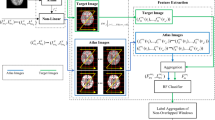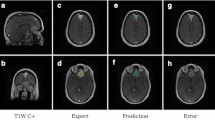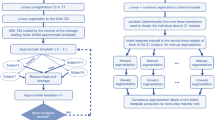Abstract
A fully automated method has been developed for segmentation of four different structures in the neonatal brain: white matter (WM), central gray matter (CEGM), cortical gray matter (COGM), and cerebrospinal fluid (CSF). The segmentation algorithm is based on information from T2-weighted (T2-w) and inversion recovery (IR) scans. The method uses a K nearest neighbor (KNN) classification technique with features derived from spatial information and voxel intensities. Probabilistic segmentations of each tissue type were generated. By applying thresholds on these probability maps, binary segmentations were obtained. These final segmentations were evaluated by comparison with a gold standard. The sensitivity, specificity, and Dice similarity index (SI) were calculated for quantitative validation of the results. High sensitivity and specificity with respect to the gold standard were reached: sensitivity >0.82 and specificity >0.9 for all tissue types. Tissue volumes were calculated from the binary and probabilistic segmentations. The probabilistic segmentation volumes of all tissue types accurately estimated the gold standard volumes. The KNN approach offers valuable ways for neonatal brain segmentation. The probabilistic outcomes provide a useful tool for accurate volume measurements. The described method is based on routine diagnostic magnetic resonance imaging (MRI) and is suitable for large population studies.
Similar content being viewed by others
Log in or create a free account to read this content
Gain free access to this article, as well as selected content from this journal and more on nature.com
or
Abbreviations
- CEGM:
-
central gray matter
- COGM:
-
cortical gray matter
- CSF:
-
cerebrospinal fluid
- FN:
-
false negative
- FP:
-
false positive
- IR:
-
inversion recovery
- KNN:
-
K nearest neighbor
- PD:
-
proton density weighted
- SI:
-
Dice similarity index
- T1-w:
-
T1-weighted
- TN:
-
true negative
- TP:
-
true positive
- T2-w:
-
T2-weighted
- WM:
-
white matter
References
Hack M, Taylor HG 2000 Perinatal brain injury in preterm infants and later neurobehavioral function. JAMA 284: 1973–1974
Marlow N, Wolke D, Bracewell MA, Samara M 2005 Neurologic and developmental disability at six years of age after extremely preterm birth. N Engl J Med 352: 9–19
Resnick MB, Armstrong S, Carter RL 1988 Developmental intervention program for high-risk premature infants: effects on development and parent-infant interactions. J Dev Behav Pediatr 9: 73–78
McCarton CM, Wallace IF, Bennett FC 1996 Early intervention for low-birth-weight premature infants: what can we achieve?. Ann Med 28: 221–225
1998 Randomized trial of parental support for families with very preterm children. Avon Premature Infant Project. Arch Dis Child Fetal Neonatal Ed 79: F4–F11
Inder TE, Hűppi PS, Warfield S, Kikinis R, Zientara GP, Barnes PD, Jolesz F, Volpe JJ 1999 Periventricular white matter injury in the premature infant is followed by reduced cerebral cortical gray matter volume at term. Ann Neurol 46: 755–760
Hűppi PS, Inder TE 2001 Magnetic resonance techniques in the evaluation of the perinatal brain: recent advances and future directions. Semin Neonatol 6: 195–210
Inder TE, Warfield SK, Wang H, Hüppi PS, Volpe JJ 2005 Abnormal cerebral structure is present at term in premature infants. Pediatrics 115: 286–294
Woodward LJ, Anderson PJ, Austin NC, Howard K, Inder TE 2006 Neonatal MRI to predict neurodevelopmental outcomes in preterm infants. N Engl J Med 355: 685–694
Chard DT, Parker GJ, Griffin CM, Thompson AJ, Miller DH 2002 The reproducibility and sensitivity of brain tissue volume measurements derived from an SPM-based segmentation method. J Magn Reson Imaging 15: 259–267
Lemieux L, Hammers A, Mackinnon T, Liu RS 2003 Automatic segmentation of the brain and intracranial cerebrospinal fluid in T1-weighted volume MRI scans of the head, and its application to serial cerebral and intracranial volumetry. Magn Reson Med 49: 872–884
Shattuck DW, Sandor-Leahy SR, Schaper KA, Rottenberg DA, Leahy RM 2001 Magnetic resonance image tissue classification using a partial volume model. Neuroimage 13: 856–876
Amato U, Larobina M, Antoniadis A, Alfano B 2003 Segmentation of magnetic resonance brain images through discriminant analysis. J Neurosci Methods 131: 65–74
Kovacevic N, Lobaugh NJ, Bronskill MJ, Levine B, Feinstein A, Black SE 2002 A robust method for extraction and automatic segmentation of brain images. Neuroimage 17: 1087–1100
Marroquin JL, Vemuri BC, Botello S, Calderon F, Fernandez-Bouzas A 2002 An accurate and efficient bayesian method for automatic segmentation of brain MRI. IEEE Trans Med Imaging 21: 934–945
Cocosco CA, Zijdenbos AP, Evans AC 2003 A fully automatic and robust brain MRI tissue classification method. Med Image Anal 7: 513–527
Toft PB, Leth H, Ring PB, Peitersen B, Lou HC, Henriksen O 1995 Volumetric analysis of the normal infant brain and in intrauterine growth retardation. Early Hum Dev 43: 15–29
Hűppi PS, Warfield S, Kikinis R, Barnes PD, Zientara GP, Jolesz FA, Tsuji MK, Volpe JJ 1998 Quantitative magnetic resonance imaging of brain development in premature and mature newborns. Ann Neurol 43: 224–235
Tolsa CB, Zimine S, Warfield SK, Freschi M, Rossignol AS, Lazeyras F, Hanquinet S, Pfizenmaier M, Hűppi PS 2004 Early alteration of structural and functional brain development in premature infants born with intrauterine growth restriction. Pediatr Res 56: 132–138
Zacharia A, Zimine S, Lovblad KO, Warfield S, Thoeny H, Ozdoba C, Bossi E, Kreis R, Boesch C, Schroth G, Hűppi PS 2006 Early assessment of brain maturation by MR imaging segmentation in neonates and premature infants. AJNR Am J Neuroradiol 27: 972–977
Prastawa M, Gilmore JH, Lin W, Gerig G 2005 Automatic segmentation of MR images of the developing newborn brain. Med Image Anal 9: 457–466
Warfield SK, Kaus M, Jolesz FA, Kikinis R 2000 Adaptive, template, moderated, spatially varying statistical classification. Med Image Anal 4: 43–55
Mewes AU, Hüppi PS, Als H, Rybicki FJ, Inder TE, McAnulty GB, Mulkern RV, Robertson RL, Rivkin MJ, Warfield SK 2006 Regional brain development in serial magnetic resonance imaging of low-risk preterm infants. Pediatrics 118: 23–33
Groenendaal F, Veenhoven RH, van der Grond J, Jansen GH, Witkamp TD, de Vries LS 1994 Cerebral lactate and N-acetyl-aspartate/choline ratios in asphyxiated full-term neonates demonstrated in vivo using proton magnetic resonance spectroscopy. Pediatr Res 35: 148–151
Maes F, Collignon A, Vandermeulen D, Marchal G, Suetens P 1997 Multimodality image registration by maximization of mutual information. IEEE Trans Med Imaging 16: 187–198
Duda RO, Hart PE 2001 Pattern Classification. John Wiley & Sons, New York, pp 174–195
Bishop CM 1995 Neural networks for pattern recognition. Oxford University Press, Oxford, Great Britain, pp 55–59
Cover TM 1968 Estimation by the nearest neighbor rule. IEEE Trans Inf Theory 1: 50–55
Dice LR 1945 Measures of the amount of ecologic association between species. Ecology 26: 297–302
Bartko JJ 1991 Measurement and reliability: statistical thinking considerations. Schizophr Bull 17: 483–489
Aylward S, Coggins J 1994 Spatially invariant classification of tissues in MR images. Vis Biomed Comp 2359: 353–361
Anbeek P, Vincken KL, van Bochove GS, van Osch MJ, van der Grond J 2005 Probabilistic segmentation of brain tissue in MR imaging. Neuroimage 27: 795–804
Peterson BS, Vohr B, Staib LH, Cannistraci CJ, Dolberg A, Schneider KC, Katz KH, Westerveld M, Sparrow S, Anderson AW, Duncan CC, Makuch RW, Gore JC, Ment LR 2000 Regional brain volume abnormalities and long-term cognitive outcome in preterm infants. JAMA 284: 1939–1947
Author information
Authors and Affiliations
Corresponding author
Additional information
Financial support for this study was provided by Philips Medical Systems, Best, The Netherlands.
Rights and permissions
About this article
Cite this article
Anbeek, P., Vincken, K., Groenendaal, F. et al. Probabilistic Brain Tissue Segmentation in Neonatal Magnetic Resonance Imaging. Pediatr Res 63, 158–163 (2008). https://doi.org/10.1203/PDR.0b013e31815ed071
Received:
Accepted:
Issue date:
DOI: https://doi.org/10.1203/PDR.0b013e31815ed071
This article is cited by
-
An efficient memory reserving-and-fading strategy for vector quantization based 3D brain segmentation and tumor extraction using an unsupervised deep learning network
Cognitive Neurodynamics (2024)
-
Two-dimensional ultrasound measurements vs. magnetic resonance imaging-derived ventricular volume of preterm infants with germinal matrix intraventricular haemorrhage
Pediatric Radiology (2020)
-
Multi stream 3D hyper-densely connected network for multi modality isointense infant brain MRI segmentation
Multimedia Tools and Applications (2019)
-
Multimodality evaluation of the pediatric brain: DTI and its competitors
Pediatric Radiology (2013)
-
Stereological evaluation of the volume and volume fraction of newborns’ brain compartment and brain in magnetic resonance images
Surgical and Radiologic Anatomy (2012)



